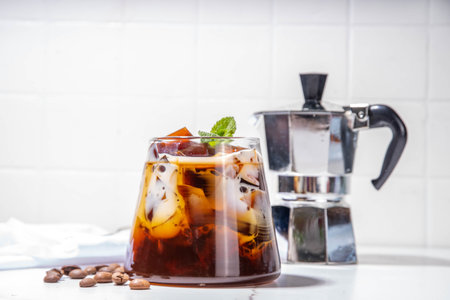Introduction to Cold Brew in Britain
Over the past few years, cold brew coffee has been making waves across Britain, transforming from a niche curiosity to a beloved staple in both independent cafés and high street chains. While the British are renowned for their deep-rooted tea traditions, the nation’s coffee scene is flourishing with innovative trends, and cold brew stands out as one of the most notable. Fuelled by a desire for smoother, less acidic coffee and an appreciation for sophisticated brewing methods, cold brew has carved a unique space in British coffee culture. London’s vibrant café districts, Manchester’s artisan coffee shops, and even local village bakeries now serve this chilled delight, reflecting how Brits are embracing global influences while adding their own twist. Whether enjoyed over ice on a rare sunny day or served with a splash of milk during morning commutes, cold brew speaks to the modern British taste—refreshing, convenient, and effortlessly stylish.
Essential Kit for Brewing at Home
Before you embark on your cold brew journey, it’s worth taking a moment to gather the right equipment—a blend of classic British kitchen staples and contemporary coffee essentials. The beauty of DIY cold brew lies in its simplicity, so there’s no need to invest in fancy gadgets. Here’s a quick guide to what you’ll need, plus a few tips to make the process seamless in any British kitchen.
| Item | Why It Matters | Local Tip |
|---|---|---|
| Cafetiere (French Press) | The traditional British cafetiere is ideal for steeping and filtering your cold brew—no need for specialist gear. | If you don’t have one, a large Mason jar or even a sturdy teapot will do in a pinch. |
| Locally Roasted Coffee Beans | Freshness is key. Sourcing beans from local UK roasters not only supports small businesses but also guarantees vibrant flavour notes unique to British terroir. | Look for roasters in your area—many offer single-origin beans perfect for cold brew. |
| Filtered Water | London tap water can be hard; using filtered water ensures a smoother taste and lets the coffee shine. | A basic Brita jug works wonders for home brewers. |
| Kilner Jar or Large Jug | You’ll need something sizeable to steep your grounds overnight. A classic Kilner jar is both practical and stylish on any kitchen shelf. | Repurpose empty glass jars—sustainability meets utility! |
| Fine Mesh Sieve or Muslin Cloth | For straining out grounds, opt for a fine sieve or an old-school muslin cloth—both are common in most UK kitchens. | A clean tea towel can double up if you’re caught short. |
| Spoon and Scales | Consistency matters: use digital scales for precision, but trusty tablespoons work too if you prefer a more relaxed approach. | Baking scales already in your cupboard are perfectly suited to the job. |
With these essentials at hand, you’re ready to channel that effortless British style into every cup. Remember, the best home brewing kit is often what you already own—just with a bit of clever repurposing and local flair. In the next section, we’ll walk through preparing your beans and assembling everything for a smooth, flavourful cold brew experience tailored to life in the UK.
![]()
3. Selecting the Right Coffee Beans
When crafting the perfect cold brew in your British kitchen, one of the most crucial steps is choosing the right coffee beans. For a truly local experience, seek out beans roasted by reputable British roasteries—these not only support homegrown businesses but also offer an array of freshly roasted options tailored to suit various palates. Look for roasters who provide transparent sourcing and roasting dates, ensuring freshness and quality in every batch.
When it comes to flavour notes, cold brew brings out unique characteristics in coffee beans that might otherwise go unnoticed in a hot brew. For a classic, smooth cold brew, opt for medium to dark roasted beans with chocolatey, nutty, or caramel undertones—these flavours tend to shine through when steeped slowly in cold water. If you’re feeling adventurous or prefer a brighter profile, try lighter roasts featuring British-roasted single origins from Africa or Central America; these often lend fruity or floral notes that can be surprisingly refreshing when chilled.
Don’t hesitate to ask your local barista or visit independent coffee shops for recommendations on which British-roasted beans are best suited to cold brew. Many roasters across the UK curate blends or single-origin selections specifically intended for this brewing method. Whether you favour bold, comforting richness or light, zesty complexity, selecting the right beans is the first step towards elevating your homemade cold brew to café-quality standards.
4. Step-by-Step Method: Brewing Cold Brew the British Way
If you’re ready to craft your own cold brew right at home, this method is tailored for British kitchens, where kettles and teapots are as common as a rainy afternoon. Here’s a detailed guide to help you master the DIY cold brew process with timings and practical temperature tips suited for the UK climate.
What You’ll Need
| Item | Recommended Type | British Alternative |
|---|---|---|
| Coarse Ground Coffee | Single-origin or blend, medium roast | Your favourite local roaster (e.g., Union, Caravan) |
| Filtered Water | Cold, fresh water | Brita-filtered tap water |
| Large Jar or Jug | 1L capacity minimum | Mason jar or classic glass jug |
| Coffee Filter or Muslin Cloth | Cone filter or fine mesh sieve | Reusable muslin cloth or cafetière plunger |
| Spoon & Scales | For accurate measuring | Kitchenscale and tablespoon |
The Brewing Process: Step by Step
- Measure & Mix: Use a ratio of 1:8 coffee to water (e.g., 100g coffee to 800ml water). Place the ground coffee in your jar or jug, then add filtered water. Stir gently with a spoon to ensure all grounds are saturated.
- Steep & Wait: Cover the jar loosely and let it steep at room temperature (ideally between 18–21°C). In a typical British kitchen, allow 12–16 hours overnight on the counter.
- Strain: After steeping, strain the mixture through a muslin cloth, fine mesh sieve, or pour slowly through a cafetière plunger. If you prefer a cleaner cup, double filter using both a mesh sieve and paper filter.
- Bottle & Chill: Transfer the strained cold brew into a clean bottle or jug. Store it in the fridge for up to 5 days; chilling it brings out its refreshing character—perfect for unpredictable British weather.
- Serve: Pour over ice, dilute with cold water or milk to taste. For an extra touch of style, serve in a highball glass with a twist of lemon zest—a nod to British elegance.
Temperature and Timing Tips for British Homes
- If your kitchen is particularly chilly (below 16°C), extend steeping time to 16–18 hours for fuller extraction.
- Avoid direct sunlight during steeping—British sun may be rare, but it can affect flavour clarity if you’re lucky enough to catch it!
- Brewed concentrate can be diluted up to 1:2 with still or sparkling water for lighter sipping—ideal for those rare balmy days.
This hands-on approach ensures every cup of homemade cold brew fits seamlessly into your daily routine while embracing local kitchen culture and taste preferences. With practice, you’ll find your signature cold brew style that’s unmistakably British yet universally delicious.
5. Straining, Storing and Serving Suggestions
Easy Home Straining Techniques
Once your cold brew has steeped to perfection, it’s time for straining—a step that transforms gritty grounds into a smooth, velvety drink. The simplest way is to pour the mixture through a fine mesh sieve lined with a clean muslin cloth or coffee filter, right over a jug. If you’re after a truly clear finish, double strain it using both a sieve and filter paper. Many British kitchens already have these items to hand, making the process fuss-free and mess-minimised.
Storing Your Cold Brew
After straining, decant your cold brew into a glass bottle or Kilner jar. Pop it in the fridge and it will stay fresh for up to a week—perfect for keeping you cool during unpredictable British summers or when guests pop by unannounced. For easy access, consider pouring some into smaller bottles for grab-and-go convenience.
Creative Ways to Present Cold Brew
Presentation is half the pleasure. Serve your cold brew over large ice cubes in a crystal tumbler for timeless elegance, or in vintage enamel mugs for a dash of countryside nostalgia. Add a slice of lemon or orange peel for a subtle twist, or top with a splash of tonic water for an effervescent afternoon pick-me-up. For an extra dash of style, garnish with edible flowers or sprigs of garden-fresh mint.
Classic British Accompaniments
No cold brew experience would be complete without a nod to beloved British treats. Pair your chilled coffee with buttery shortbread biscuits, homemade scones slathered in clotted cream, or delicate finger sandwiches—a nod to traditional afternoon tea with a contemporary twist. Whether enjoyed solo or shared amongst friends, these pairings bring together the best of British hospitality and continental café culture.
6. Sustainable Brewing and British Twists
Embracing sustainability in your cold brew routine isn’t just good for the planet—it adds a thoughtful layer to your daily ritual, especially in the context of British kitchens. Start by minimising waste: opt for reusable coffee filters or a French press instead of disposable alternatives, and compost your used coffee grounds—these can be sprinkled over rose bushes or added to your allotment soil for an eco-friendly boost. When it comes to ingredients, consider swapping imported beans for single-origin varieties roasted right here in the UK; supporting local roasteries not only reduces your carbon footprint but also celebrates Britain’s burgeoning coffee scene.
For a uniquely British twist, experiment with infusing your cold brew with local botanicals. Try adding a sprig of fresh mint from the garden, or a splash of elderflower cordial for a fragrant, summery note. A dash of oat milk from a UK producer offers a creamy finish while keeping things plant-based and sustainable. And if you’re feeling adventurous, incorporate regional flavours like Cornish sea salt or Scottish heather honey for a subtle nod to Britain’s diverse landscapes. Every cup becomes more than just coffee—it’s a celebration of mindful choices and homegrown flavour, perfect for elevating your daily brew with an unmistakable British character.


